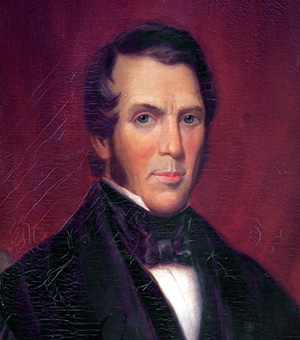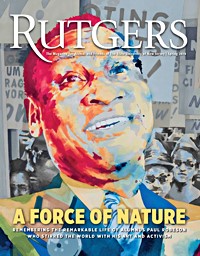Abraham Bruyn Hasbrouck
Rutgers President, 1840 to 1850

Abraham Bruyn Hasbrouck was born in Kingston, New York, and studied at Kingston Academy before entering Yale College, where he graduated in 1810. Hasbrouck attended the private law school in Litchfield, Connecticut, where he received instruction in the common law from Tapping Reeve and James Gould. He returned to Kingston and in 1814 began his law practice. Hasbrouck served as president of the Ulster County Bank from its inception in 1831. In 1824 he was elected to Congress where he supported Henry Clay’s policy of internal improvements.
Chosen by the trustees in 1840, Hasbrouck was the first layman to hold the office of president of Rutgers College. During his administration, the college moved closer toward establishing independence from the Reformed Dutch Church. The paucity of finances continued to plague the institution but the college was able to make some progress. The faculty increased to three full-time professors and five part-time instructors. Modern languages and expanded scientific instruction were added to the curriculum, complementing the traditional classical offering. The theological professors provided instruction in moral philosophy, evidences of Christianity, logic, and mental philosophy. In 1841 a “Scientific or Commercial Course” was introduced to accommodate students who desired specialized training; those students were awarded a certificate upon completing their studies. The course was offered through 1864, when the Rutgers Scientific School was established. Hasbrouck, in addition to his official duties as president, gave instruction in rhetoric to the junior class and presented lectures in constitutional law and political economy to the senior class. He also presided over the weekly forensic exercises for seniors.
A lawyer, Abraham Bruyn Hasbrouck was the first layman to hold the office of president of Rutgers College. During his administration the college moved closer toward establishing independence from the Reformed Dutch Church.
Other changes took place during Hasbrouck’s years in office. In 1841 the college erected a small house for the president and his family to the east of Old Queens on a plot of land leased from the church synod. Van Nest Hall was completed in 1848 and soon became home to the two literary societies, the geological museum, and chemical laboratory. The literary societies flourished in the 1840s but were soon challenged in their supremacy by the emergence of “secret societies,” or Greek-lettered fraternities. Other student activities included the first venture into student publishing in 1842 with the short-lived Rutgers Literary Miscellany.
In the midst of this thriving student life, the college failed to prosper to the trustees’ expectation. The number of students in attendance declined to a low of 65 in 1850. Relations between the trustees and the synod, amicable throughout most of the decade, once again deteriorated and the trustees suggested a reconveyance of the building and campus to the college. The complete separation of the college from the Reformed Dutch Church was not to occur for over a decade. In July 1849 Abraham Hasbrouck resigned from the presidency of Rutgers College. He remained in office until April 1850, when the college secured the appointment of Theodore Frelinghuysen. Hasbrouck spent a few years in New York City, before returning to his native Kingston, where he became the founder of the Ulster County Historical Society and lived in retirement until his death on February 23, 1879.
This biographical sketch was authored by Thomas J. Frusciano, Rutgers University Archivist. It originally appeared in The Journal of the Rutgers University Libraries.

